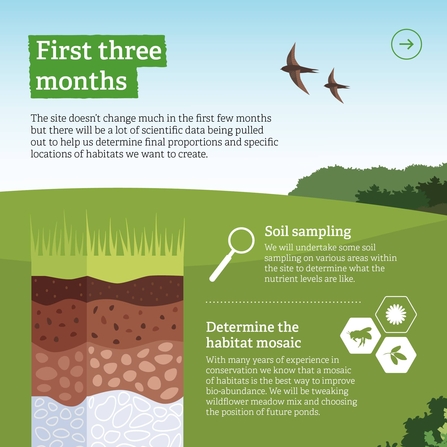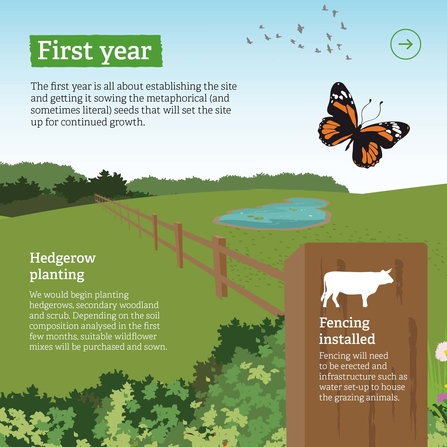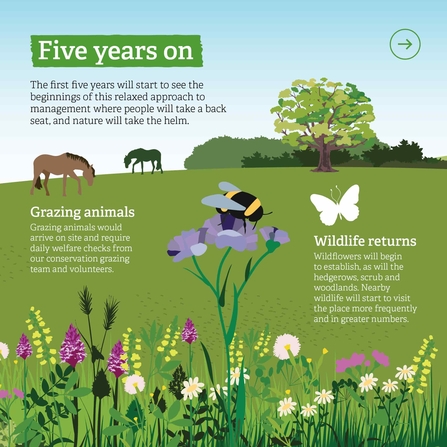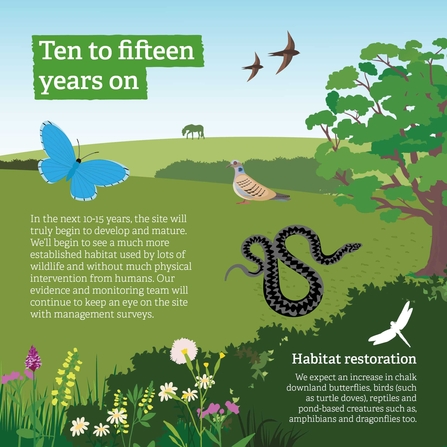We would like to have a relaxed management style at Polhill. This means that there will be little human intervention, allowing the habitat to be restored naturally and welcoming all wildlife that chooses to visit. But getting to this point does take some human intervention and initial effort – much of which is costed in our appeal and, will lead to greater biodiversity on the site. For a look at some of the species that we might see in the future, check out this blog on chalk downland species.

All graphics © Katy McCarten
First three months
The site doesn’t change much in the first few months but there will be a lot of scientific data being pulled out to help us determine final proportions and specific locations of habitats we want to create. The main survey is a phase 1 vegetation survey which takes initial inventory of everything that is on the site. As an arable field, we don’t expect to find much but having baseline data is important to compare with future surveys. This type of survey can also determine whether or not there is potential for Biodiversity Net Gain on the site.
If it cannot be determined easily by eye, we’ll also be doing some soil sampling on various areas within the site to determine what the nutrient levels are like. This would give us an indication as to what habitats the area could support. A richer area may be better for hedgerow or secondary woodland whilst a poorer area would better support a wildflower meadow.
With many years of experience in conservation we know that a mosaic of habitats is the best way to improve bio-abundance. The first three months really helps us to determine the exact proportions and locations of specific habitats. For example, we would be able to tweak the wildflower meadow seed mixture to make sure it is the most successful and we'd choose the final position of the ponds based on where the soil is the dampest. All of the above would be detailed in the existing management plan.

First year
The first year is all about establishing the site and getting it sowing the metaphorical (and sometimes literal) seeds that will set the site up for continued growth. We would begin planting hedgerows, secondary woodland and scrub. Fencing will need to be erected and infrastructure such as water set-up to house the grazing animals. Depending on the soil composition analysed in the first few months, suitable wildflower mixes will be purchased and sown.

Five years on
At the end of the first year or the beginning of the second year, any grazing animals would arrive on site and require daily welfare checks from our conservation grazing team and volunteers.
Ultimately, the first five years will start to see the beginnings of this relaxed approach to management where people will take a back seat (except for ensuring animal welfare), and nature will take the helm. Wildflowers will begin to establish, as will the hedgerows, scrub and woodlands. Nearby wildlife will start to visit the place more frequently and in greater numbers.

10 -15 years on
In the next 10-15 years, the site will truly begin to develop and mature. We’ll begin to see a much more established habitat used by lots of wildlife and without much physical intervention from humans. Of course, it would be difficult to predict what species will be there as we let nature take its own course though we expect an increase in chalk downland butterflies, birds (such as turtle doves), reptiles and pond-based creatures such as, amphibians and dragonflies too. Our evidence and monitoring team will continue to keep an eye on the site with management surveys which are a system of surveys we use across key reserves to ensure that the plans for the site are on track and if they’re not, what needs to change in the management plan to adapt and continue to improve biodiversity.
How can you help?
The good news is, similar methods have already worked on Polhill Bank, just across the road from the extension land we are hoping to purchase. This three-acre site is a haven to wildlife and started off much like this site, as arable land – you can find out more about its transformation here.
At the time of publishing, we have raised £107,496 and have less than 50% of the way to go! Can you help us with the final push? Please spread the word if you can, even a little goes a long way.